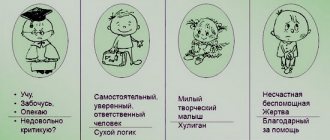Eric Lennard Byrne
According to the theory of transactional analysis [1], which was proposed and developed by American psychotherapist Eric Berne at the beginning of the last century, our ability to speak convincingly, think adequately, feel and respond to what is happening is determined by one of our three ego states - Child, Adult or Parent.
Introduction to transactional analysis. Ego states according to Eric Berne:
- I am a Parent
- I'm an Adult
- I am a child
Our ego states are our psychological reality. Each of them has a certain value for us. All three as a whole and each of them individually are extremely important for our survival and equally necessary for fruitful life and communication.
Transactions are the building blocks of our relationships
In order to analyze our verbal or nonverbal communication more easily, Eric Berne proposed breaking down the entire process of interaction between people into elementary pieces - transactions. A transaction, as a unit of communication, describes single interactions between people taking into account three ego components.
According to Berne's structural analysis , communication between two people is always a contact of certain states of their I. When one of the participants in the dialogue sends a stimulus to the other, and the other reacts to this stimulus with at least one of his I-states, communication can be considered completed. If one I-state from each is enough for interlocutors to communicate, such a transaction is called simple.
Considering what states of our Self are involved in communication and how they interact, a transaction can be classified into one of three types:
- Complementary or complementary
- Intersecting or cross
- Hidden
Technique 5. Determining the life scenario
To determine the life scenario, special questionnaires are used. The responses are then analyzed to determine the prevailing scenario. In addition, to find out the favorite behavior scenario, exercises such as telling a fable and imagining oneself as its hero, telling a dream, playing on stage, etc. are used. Find out who a person’s favorite hero is, what his favorite fable or story is.
A scenario of behavior in stressful situations that ended negatively for the patient is definitely being worked out, how he behaved now, several years ago, in adolescence and childhood, and what exactly led to the negative result. This scenario needs to be replaced with another that brings success. The technique also allows you to eliminate negative and limiting patterns and identify activating drivers in order to use them more often.
Complementary or complementary transactions
Since we are all different, in the process of communication some of the states remain active, interacting with each other as basic or complementary, while others do not manifest themselves noticeably to us. In the figures below, the simplest complementary transactions are indicated by parallel lines.
- Figure 1. Complementary transactions PP-ReP
In Fig. 1, the arrows display active ego states between the two spouses. Although there are all three ego states in communication, one plays an active role on each side. The stimulating complementary influence (stimulus) is directed from the husband’s “I am the Parent” state to the wife’s “Child” state (PP). Her reaction is in the opposite direction, from the “I-Child” state to the “Parent” state of her husband (ReP).
Thus, the complementary impact in our example is a parallel transaction proceeding according to the PP – ReP scenario. Ideally, such a transaction schematically reflects the relationship in the family, when the husband takes care of his wife in a fatherly way, and she accepts such care with gratitude.
Berne called complementary or complementary transactions in which the stimulating effect emanating from one of the interlocutors is complemented by a corresponding reaction from the other participant in the communication. In this case, the stimulus vector and the reaction vector coincide. Example: “What time is it?” – stimulus, “Twenty minutes to seven” – reaction. Complementary transactions are common when the “Adult” I-states of interlocutors are in contact.
Important: As long as the transaction is executed as complementary, it can develop indefinitely, regardless of its content, since the situation completely suits both parties and does not contain grounds for conflict.
Figure 2. Diagram of nine types of complementary transactions
Three basic ego states are capable of compiling 9 different types of simple complementary transactions - PP, PB, PPe, BP, BB, BPe, ReP, ReB, ReRe. (Fig. 2).
In practical work, psychologists distinguish:
- Three types of complementary equal transactions in which communication occurs between the same states of the participants in the dialogue (PP, BB, ReRe):
- Along the lines of RR, we usually scratch our tongues and repeat platitudes: ...Youth have lost all shame - I completely agree...
Via BB lines - we are in contact at work: ... Give me that screwdriver - Take it ... or we exchange operational information: ... What time is it? - Midnight...
- According to the lines of ReRe, we love and indulge in entertainment: ... Maybe we’ll go to the cinema? - Great idea…
- Unequal transactions arising in situations of guardianship, care, suppression or admiration.
The lines connecting the I-states in all the listed cases in Fig. 2 are parallel to each other.
Overlapping or cross transactions
If the arrows of stimulus and response intersect, then such interactions in the language of transactional analysis of communication are called intersecting or cross. An overlapping transaction occurs when, in response to a stimulus from one of the interlocutors, directed towards one ego state of the interlocutor, the latter reacts on behalf of his other ego state.
Overlapping transactions are one of the most likely sources of interpersonal conflict.
— Husband to wife: “Where did you put my cufflinks?” Stimulus BB – the “Adult” of the husband addresses the “Adult” of the wife.
— Wife: “When was the last time you remembered where you put your thing?” RW’s reaction – the wife’s “Parent” mentors the “Adult” husband.
There is an intersecting transaction BB – PB. The ground has been prepared for the development of conflict.
— Husband to wife: “Where is my tie?” Stimulus BB – the “Adult” of the husband addresses the “Adult” of the wife.
— Wife: “Why do you always try to blame me for everything?” ReR’s reaction – the wife’s “Child” pouts offendedly and calls out to the husband’s “Parent”.
It is clear that further conversation about the tie becomes impossible, since, in the language of psychotherapy, there is a classic “transfer” of emphasis from problems at the everyday level to the level of relationships. We have before us an intersecting transaction of the 1st type BB – ReP. Transactions of this kind are the main source of our everyday conflicts.
- Rice. 2a Intersecting transactions of type 1 in Fig. 2a according to the BB – ReR scheme
Beginning with mutual reproaches at the everyday level, cross-transactions often end in violent quarrels, accompanied by door slamming and rapid changes in ego states for each of the parties to the conflict.
— Work colleague: “You don’t know, the boss is holding a planning meeting today?” Stimulus BB - the “Adult” of one of the employees addresses the “Adult” of another, equal in status.
— Second colleague: “I know, but when will you be able to answer such questions for me?” Reaction PP - the “Parent” of the colleague to whom the stimulus was addressed, in the tone of a patron, teaches the “Child” of the colleague who asked the question.
The intersecting transaction of the 2nd type BB - PP corresponding to the described situation is illustrated in Fig. 2b. Such transactions in psychiatry correspond to countertransference reactions. They often fuel conflicts in their personal lives and on diplomatic grounds.
- Figure 2b. Intersecting transactions of the 2nd type according to the BB-PP scheme
Important: Overlapping transactions are a sign of a breakdown in communication and potential conflict. Proceeding rapidly, such conflicts, as a rule, quickly fade, but will continue to occur until their cause is found and eliminated.
Three basic ego states, according to the theory of transactional analysis, are decomposed into 9 x 9 = 81 different schemes for the implementation of simple transactions. After deducting 9 complementary transactions, 72 options remain. – A bit much even for a transactional analyst.
At the “applied” level of an ordinary person, for a productive analysis of the structure of relationships, it is quite enough to learn to recognize and operate with the 4 most common schemes of paired transactions of the same level:
- BB – ReR is a variant of the transfer reaction (example in Fig. 2a).
- BB – PP – a variant of the countertransference reaction (example in Fig. 2b).
- ReR - BB is a reaction of irritation that characterizes the state of a person who expects sympathy and receives dry facts instead.
- RR – BB – insolence. Instead of the expected complaint, the author of the stimulus hears a response, which he perceives as a challenge and appeals to facts.
Classification of games
E. Burn in his works identifies the following classification of games:
- Number of players: games for two (“Frigid Woman”), for three (“Come on, fight!”), for five (“Alcoholic”) and for many (“Why don’t you.” - “Yes, but... ").
- Material used: words (“Psychiatry”), money (“Debtor”), body parts (“I need surgery”).
- Clinical types: hysterical (“They’re raping!”), with obsessiveness syndrome (“Blubber”), paranoid (“Why does this always happen to me?”), depressive (“I’m back to my old ways again”).
- By zone: oral (“Alcoholic”), anal (“Blubber”), phallic (“Let’s fight”).
- Psychodynamic: counterphobia (“If it weren’t for you”), projecting (“Parental Committee”), introjecting (“Psychiatry”).
- Classification by instinctive drives: masochistic (“If it weren’t for you”), sadistic (“Blubber”), fetishistic (“Frigid Man”)
Burn also gives a classification of games based on the main qualitative characteristics:
- Flexibility. Some games, such as Debtor or I Need Surgery, can only be played on one material, while others, such as exhibitionist games, are much more flexible.
- Tenacity. Some people give up games easily, others are much more attached to them.
- Intensity. Some play relaxed, others are more tense and aggressive. Games can be light or hard accordingly.
Any game has a significant impact on a person’s life, some games last a lifetime.
Hidden transactions
Hidden transactions turn out to be more complex in their understanding and structure, when people say one thing and mean another, or are completely unaware of which of the three Ego components they are currently speaking on behalf of. Two or more self-states are involved in such transactions at different levels. The initial “premise” in a hidden transaction is disguised as an externally neutral stimulus, while the response is expected in the form of a hidden message.
By participating in hidden transactions, participants in a dialogue convey information in an implicit form. At the same time, the author of the stimulus expects to influence the interlocutor in a way that he is not aware of. The hidden transaction is executed at two levels. One of them is the external, conscious social level, in which two Adult interlocutors participate in communication. The second is hidden, psychological, in which the Child of one interlocutor is provoked by one of the I-states of the second interlocutor. Initiative at a hidden level stimulates the Adult of one interlocutor, but the outcome is always determined by the reaction of the Child of the other.
Hidden transactions can be angular or double. As an example of a hidden transaction, Eric Berne considers a corner transaction involving three ego states. Sellers use corner transactions especially actively and successfully in their line of work.
Example of corner transaction 1:
— Salesperson in a wristwatch store: “Of the models that you have already seen, this one is, of course, better. But you’re unlikely to afford to buy it.” VR stimulus.
— Buyer: “You have a bad opinion of me, this is the model I chose for myself.” ReV reaction.
Having entered the Adult state, the seller, outwardly addressing the buyer’s Adult, dryly states a fact that corresponds to reality: “This model is better, but it’s too much for you.” At the same time, when pronouncing the phrase, the seller skillfully shifted the psychological emphasis, directing the stimulus to the buyer’s Child (CP). The child readily accepts the challenge (ReV), and, demonstrating that he is no worse, “agrees” with his Adult to buy an expensive watch.
Example of corner transaction 2:
— Restaurant waiter: “What will you drink?” VR stimulus.
— Visitor: “I wasn’t planning on drinking at all, I love your cuisine - I came in for a snack... Perhaps some cognac.” ReB reaction.
Externally, communication takes place on the Adult-Adult line. At the same time, the waiter’s Adult provokes the visitor’s Child, as if hinting: “How is it possible that such a respectable guest is not ready to allow himself to forget about his problems for an hour and relax a little?” (VR). As a result: The child of a restaurant visitor literally forces his Adult to order cognac from the waiter. The visitor’s answer in this case comes from the Child and contains a hidden subtext: “I will prove to you, waitress, that I am no worse than others.”
Example of a double transaction:
— He: “How about having some tea, I’m all alone here, and I live nearby?”
— She: “The idea is brilliant. I was wet and chilled to the bone.”
This is a classic double flirting transaction in which his Adult takes the initiative. The ending of the game was determined by her spontaneous, impulsive Child.
The ultimate task of transactional analysis is to learn to distinguish in what position the Self is at any given time. Recognizing the Self-state in others is quite simple if you pay attention to certain words and phrases, gestures, intonations, and facial expressions.
While in the “Parent” state, a person likes to utter commitment phrases: “I must,” “I can’t,” or criticize and instruct others in an instructive or threatening tone: “If I were you...”, “I will end this once and for all.” “,” “We shouldn’t forget that...”, “My dear, this should stop...”. At the non-verbal level, the “Parent” state manifests itself with hands crossed on the chest, in a condescending stroking of the interlocutor on the shoulder or head, a contrite sigh or shaking of the head, wrinkles appearing on the forehead.
The Child’s condition is easily diagnosed by statements in which feelings, fears, wishes predominate: “I want”, “this pisses me off”, “I hate this”, “... to hell with it”. Non-verbally, the child manifests himself in trembling lips, active gestures, shrugging shoulders, downcast gaze, and frank expressions of delight.
An adult identifies himself in his surroundings with the phrases “I can - I can’t”, “this is appropriate”, “from my point of view” and the like. His gestures are leisurely and restrained, his tone is judicious.
Technique 1. Determining ego states
First, a person must fill out a column of behavior patterns for each subpersonality - child, adult and parent. He is offered a list of actions, feelings, gestures, statements and thoughts of each subpersonality, and the patient himself fills out the columns for each of them. After this, you need to determine which of the subpersonalities takes up what time during the day. This is how the dominant subpersonality is determined. Sometimes data is plotted as a bar graph. After analysis, a person determines what exactly he would like to change, which subpersonality to influence.
Communication is a joy
The ideas of Eric Berne's transactional analysis will become visible and tangible for you when they are supported by personal experience. By carefully observing the verbal and nonverbal behavior of others, over time you will learn to recognize and diagnose ego states as easily as reading your favorite book.
From this moment on, games with your triune Ego, from dangerous diving among the sharp reefs of chaotic transactions, will turn into an exciting, and most importantly, pleasant and conscious journey under a sail filled with a tailwind. You will learn to communicate even with those people whom you previously avoided and make one unexpected and pleasant discovery: communicating with almost any person can bring true pleasure.
The concept of transaction analysis
Definition 1
Transactional analysis is a psychological model that describes human behavior both individually and as part of a group. This model includes not only a psychological and conflictological approach, but also a philosophical one.
Transactional analysis is based on psychoanalysis and represents a special model, presented in simple and accessible language. It is based on the position that the same person, being in a certain situation, can function differently, based on being in a certain ego state. Each person can think independently, learn, make decisions, openly express their feelings, not only at home, but also at work, at school, when communicating with peers or neighbors, because in any place where people exist.
Are you an expert in this subject area? We invite you to become the author of the Directory Working Conditions
The foundations of this theory were developed and described by Eric Berne, as well as a number of other psychotherapists. Scholars in a variety of fields have also studied transaction analysis. The first studies in this area were published back in the 1960s, but the peak of public interest in the problem under consideration occurred in the early 1970s.









